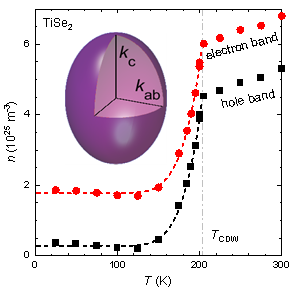Electrons in metals occupy states with high velocities. Researchers at the University of Bristol use experiments and computational simulations to study the distribution of electron states. This is carried out in a variety of materials ranging from superconductors to low-dimensional devices. Understanding the distribution of velocities for all electrons provides fundamental understanding of most properties of metals. This includes the electrical resistance, thermal conductivity, and is at the basis of many applications.
Reconstructed Fermi surface in the charge-density-wave state of TiSe2
Sven Friedemann's group published a paper in Physical Review Letters showing the abrupt and profound reconstruction of the Fermi surface in the layered material TiSe2. Electrical resistivity and Hall resistivity measurements were conducted by two MSc project students. They revealed an 80% loss of charge carriers reflecting the reconstruction of the Fermi surface.
This was complemented by quantum oscillation measurements at the high-magnetic field facilities in Nijmegen, NL. The group demonstrated how electrons localise at the onset of charge order in TiSe2. The study's high-quality crystals were grown both by Professor Wilson at the HH Wills Laboratory in the 1960s and collaborators at the University of Bath.
Layered materials like TiSe2 are at the focus of a wide spread of research. The transition metal dichalcogenides remain at the centre of these efforts even after many decades of research. This is fuelled by the multitude of physical phenomena including superconductivity and charge order. It is also fuelled by the prospect of these compounds for applications in thermoelectrics, batteries, and sensors.

Loss of charge-carrier concentration below the charge-density-wave transition temperature and the resulting Fermi surface (inset).
Electrons mobilising in a Mott insulator
The so-called Fermi surface shows the boundary between occupied and unoccupied electron states. It is most important for electronic applications of materials. Researchers from the University of Bristol detected the Fermi surface after transforming the insulator NiS2 into a metal. This was done by applying high pressures.
NiS2 is a Mott insulator at ambient pressure. The strong Coloumb repulsion between electrons causes a grid-locked state in which all electrons are localised at ambient pressure. At high pressures these electrons become mobile again and the material becomes metallic.
Now, the Fermi surface of the high-pressure metallic state has been directly detected for the first time. This was carried out using quantum oscillation measurements. The research confirms a 50 year old theorem that the electron count has to be preserved and that the insulating state is realised through a slowing down of the electrons as the quantum phase transition is approached. The results were published in Scientific Reports - the open access journal of the Nature publishing group.

The frequency of the quantum oscillations correspond to the belly orbit (red line) of the calculated cube-shaped Fermi surface.


